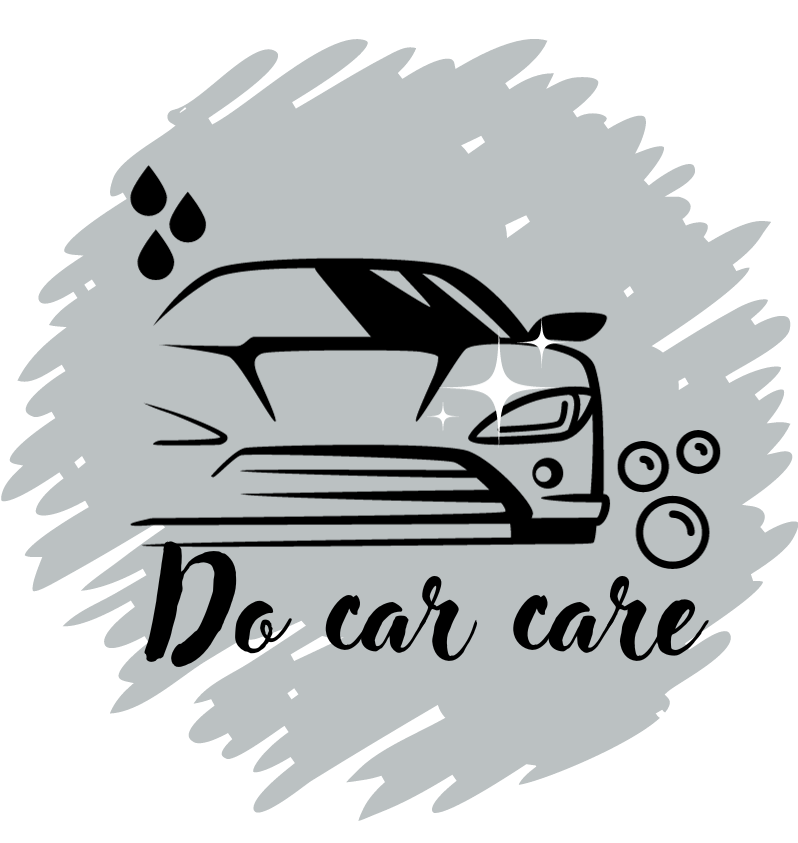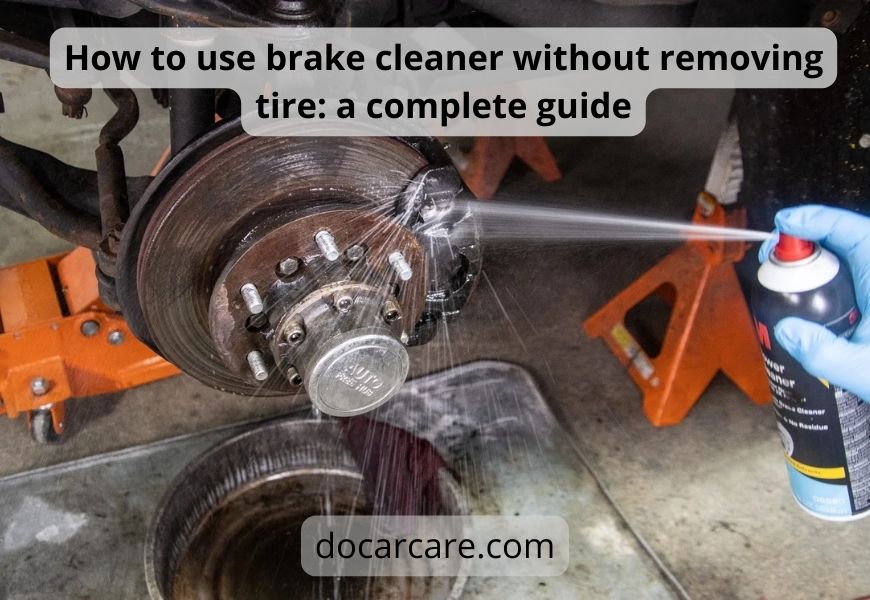How to use brake cleaner without removing tire? One of the most important parts of car maintenance is making sure your car’s braking system is operating at peak efficiency.
Maintaining effective and clean brake parts, especially the brake calipers, brake rotors, and brake pads, is essential to this.
Usually, the accumulation of brake dust and surface rust can hinder the braking force, resulting in problems like brake noise and a less sensitive brake pedal.
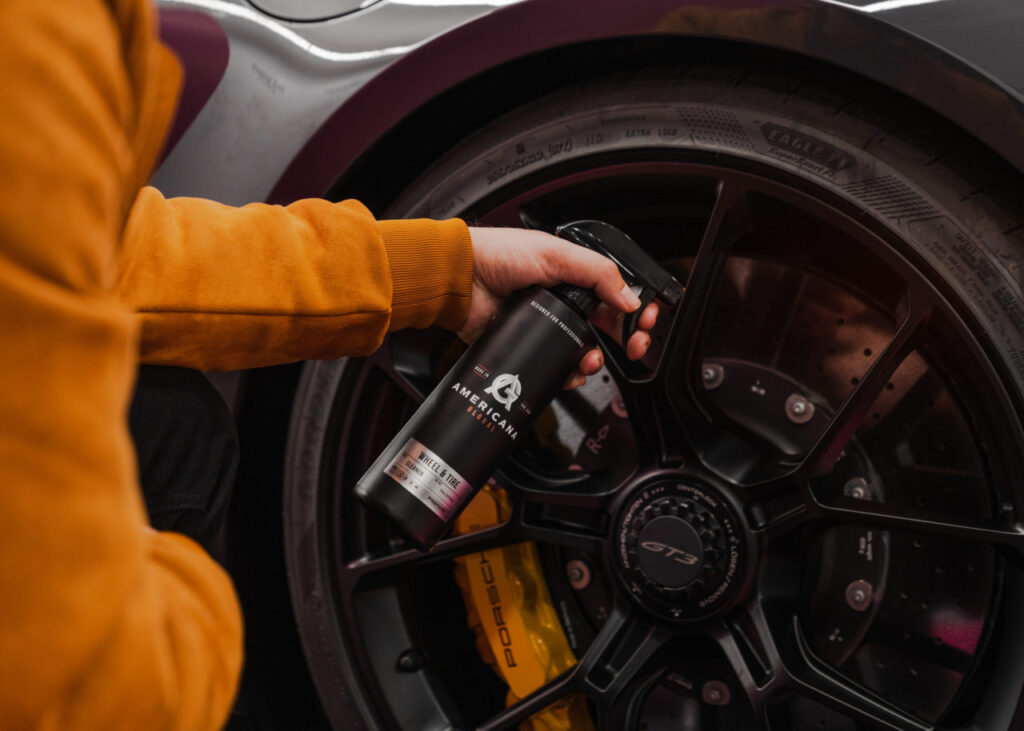
This extensive instruction, which focuses on parts like the brake pads, brake drums, and disc brakes, is intended to show you how to use brake cleaner without removing tire.
I will discuss the subtleties of using a brake cleaner on various brake parts, such as brake caliper units and brake linings, without having to routinely disassemble the brakes or remove brake fluid, or remove brake dust.
Learn how to keep your car’s brake rotors clean using a brake cleaner and in good condition so that the entire braking system — including the brake discs and brake calipers — functions properly using a cleaner.
You will have a thorough understanding of brake maintenance after reading this article, especially about cleaning brake rotors and brake pads, which improves stopping ability and comfort on the steering wheel of your vehicle.
It shows you how to take care of disc brakes and drum brakes, clean up surface rust, and make sure your brake system is clear of dangerous debris and contaminated brake fluid.

Whether you’re trying to maintain your brake shoes and clean brake rotors or you’re dealing with surface rust on your brake rotors, knowing this information is essential for effective brake maintenance.
How Can Brake Cleaner without removing tire?
It is best to seek advice from a qualified mechanic who is knowledgeable about the best cleaner to use for your vehicle if you are unsure about the type to use.
Let’s explore how to safely clean the brakes without removing the tires after choosing one of the aforementioned cleaners.
- Park the car on a level, level surface in a well-ventilated area. It’s going to be more difficult to get mud off of your brake pads if you park your car on an uneven surface or slope. Additionally, it might harm the wheel bearings.
- It is necessary to select an appropriate wheel cleaner and get it ready for use. For cleaning brake parts, whether the spray nozzle and pipe are operating correctly or not. Take a look at our guide to the best brake cleaners for automobiles if you’re unsure about what kind of product to use.
- Examine the components of any cleaning product before purchasing. To ensure that you use the right kind of cleaning, carefully read the instructions. since it can include dangerous substances that are the source of the skin issue. Pay close attention to the directions. Examine all of the package’s labels and cautionary statements.
- Apply the cleaner to the brake assembly, the area surrounding the calipers, brake drums, or the brake discs and pads after inspecting the surface. Use it correctly and allow it to air dry. After that, reapply the brake cleaner. Continue doing this until the brake assembly is completely clean.
- Applying the cleaner to the brake surface by spraying it on from above is the most effective method. Put on goggles and gloves if you don’t want to take the chance of getting any on your hands.
- Ensure that you distribute it evenly. Applying too much cleaner at once is not advised. Even though the tires are still on, apply the brake cleaner evenly across the brake system to clean your brake.
- Let the cleaner for fifteen minutes. Next, use a towel to remove any leftover brake cleaner. Avoid cleaning the brake assembly
- It is worthwhile to try this do-it-yourself method if you don’t want to buy brake cleaner. It does a decent job of keeping your automobile safe. To clean your calipers of small particles or rust, use a wire brush.

Why is brake cleaning important?
For various reasons, brake cleaning is an essential part of car maintenance. Using brake cleaner effectively and without removing the wheels.
Sustaining brake force
To retain the best possible stopping power, brakes — more especially, the brake rotor — need to be cleaned regularly.
Reduced braking efficiency can result from these parts’ functionality being hampered by dirt, debris, and brake dust buildup.
The vehicle’s braking power can be restored and maintained by using brake cleaner to assist in removing these impurities.
Preventing uneven brake pad wear
Uneven brake pads wear can be caused by an excessive accumulation of debris on the brake rotor. Premature pad wear can be avoided by routinely cleaning your brake parts using an appropriate brake cleaner.

In the long run, this saves money by ensuring safety and lowering the need for regular replacements.
Keeping the pedal responsive
A more responsive brake pedal is a result of clean brakes. The system reacts to the driver’s input more efficiently when the brake parts — including the brake rotor and pad—are clear of dirt and dust.
Being responsive is essential for safe driving, particularly when using emergency brakes.
Increasing the brake components’ life
The lifespan of brake components can be increased by using brake cleaners regularly.
Brake cleaner, which doesn’t require removing the tire, can prevent rust and corrosion by clearing debris and corrosive materials from the brake rotor and other parts, extending the life of these parts.
Convenience and time-efficiency
Cleaning brakes may be done quickly and conveniently by learning how to use brake cleaner without having to remove the tire.
Quick maintenance is made possible by this technique, which makes it simpler for car owners to clean their brakes regularly without requiring labor-intensive disassembly or expert assistance.

Brake cleaner types
Brake cleaners come in a variety of varieties, but they always contain a solvent — both flammable and non-flammable.
Non-flammable chlorinated
Chlorine doesn’t harm painted surfaces and works as a drying agent against brake fluid or dirt. Thus, while this non-flammable cleaner with a chlorine base is among the safest, it is also the priciest.
Also, you may look for less expensive options, such as flammable.
Non-chlorinated combustible
If you wish to stay away from the dangers that come with using a chlorinated solution, a non-chlorinated brake cleaner is an excellent choice.
One of the best possibilities is an acetone-containing cleaner, which is less likely to harm paint surfaces. This is cheap and combustible.
Things not to do with brake cleaner
While maintaining your car’s brakes with brake cleaner without changing the tire can be handy, there are several important safety measures to remember to prevent damage and guarantee performance:
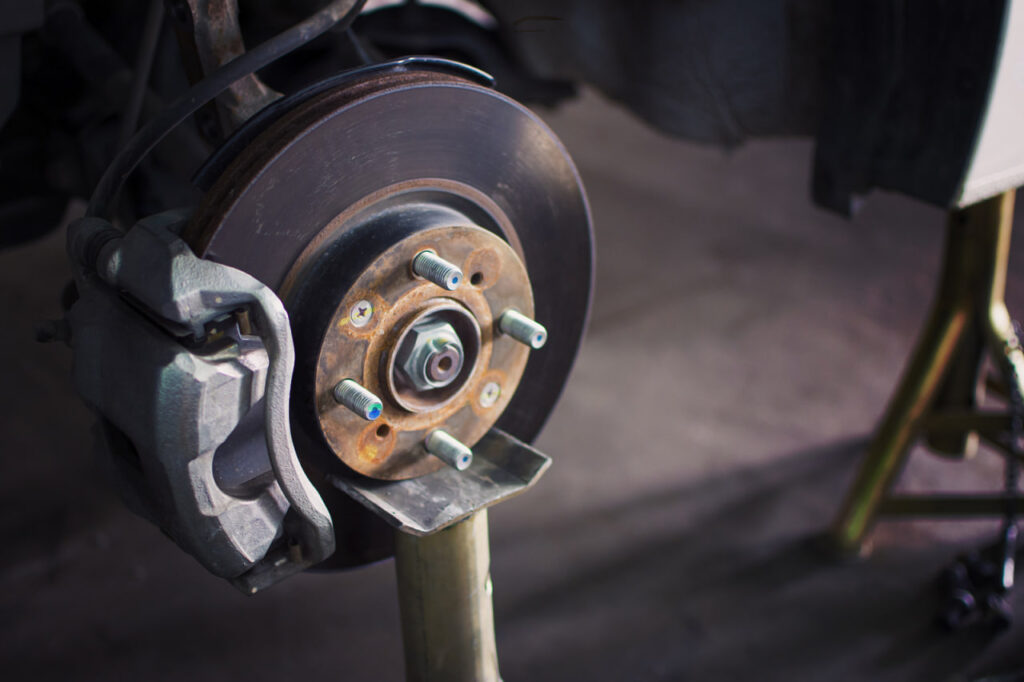
Reduce overspray risk to tires
Take caution when using brake cleaner to prevent overspray onto the tires. They contain certain compounds that might deteriorate rubber, thereby posing a safety risk.
Preventive actions
To protect the tire and other non-target locations, use cardboard or a shield.
Steer clear of non-metal parts
Rubber and Plastic Components. Rubber and plastic components may be harmed by brake cleaners. Pay attention to where the brake cleaner spray is landing while using it without taking the tire off.
Painted surfaces. Your car’s painted surfaces may also be impacted by overspray. Be careful to protect these areas.
How do you clean brake dust without removing wheels?
If you want to clean brake rotors without taking the wheels off, concentrate on cleaning the easily accessible locations to get rid of brake dust.
Apply a specific brake cleaner directly to the brake calipers and brake rotors, being sure to cover any areas that are prone to dust.
Avoid coming into direct touch with the brake fluid components while using disc brakes by spraying them onto the brake discs and pads. Although more difficult, drum brakes can be cleaned via the wheel apertures.
For best system performance, let the cleaner dissolve any brake dust and grime, then wipe down with a clean cloth to maintain ideal braking rotor and pad cleanliness.
Can I use brake cleaner to clean tire?
Generally speaking, cleaning tires with brake cleaner is not advised.
Tire rubber compounds may be harmed by chemicals used in brake cleaners, which are designed for brake components such as brake rotors, brake shoes, and brake pads.
Use a tire-specific wheel cleaner instead; it’s safer and more efficient for that kind of stuff.
How do I stop my brakes from squeaking without taking the wheel off?
Applying a brake quiet product or oil without petroleum to the rear of the brake pads will help stop clean brakes squealing.
Without removing the wheels, this is possible, albeit access may be restricted. Apply the product with caution where the brake pad and brake caliper meet.
To avoid impairing braking performance, keep lubricants off of the brake rotor and pad surfaces. Squeaking can also be lessened by routinely using a cleaner to clean the rotors and brake pads.
Can you spray brake cleaner directly on brakes?
Indeed, brake cleaner can be sprayed straight onto the brakes. It works well for cleaning brake rotors and parts, such as braking rotors and pads, of dirt, dust, and grease.
Make sure there is adequate ventilation when using a brake cleaner, and keep the cleaner away from painted surfaces as it might damage paint.
Use a clean towel to wipe off the brake cleaners after spraying it onto the brake parts and letting it evaporate.
Is it OK to spray brake cleaner on pads?
One typical way to clean and degrease brake pads is to spray brake cleaner on them; this is normally safe. Make sure the brake cleaner you use is appropriate for the type of brake pad material you have.
To get rid of any accumulated brake dust or debris, aim the spray directly onto the brake pad’s surface. Take care not to oversaturate the region, particularly in the vicinity of lines or reservoirs holding braking fluid.
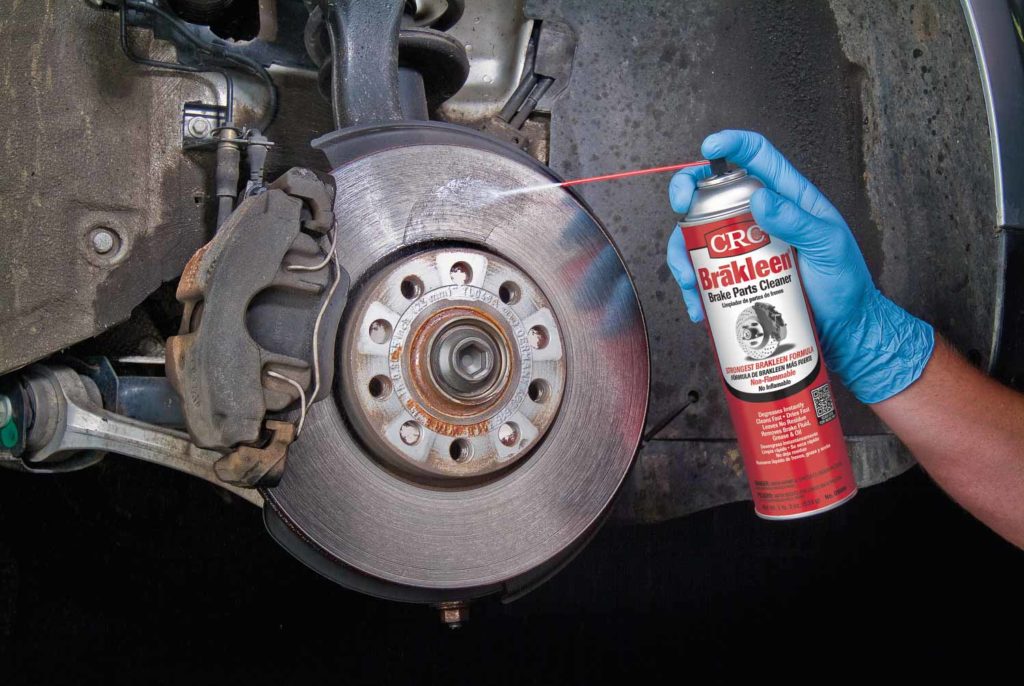
Conclusion
Maintaining the braking force of your car and ensuring safety while driving may be done effectively and economically by using brake cleaner without removing the tire.
We’ve looked at several methods in this tutorial for using brake cleaner to clean brake rotors, brake discs, and other important brake parts.
This approach yields great outcomes while saving time and effort. It is also quite convenient.
You can keep the braking system in your car free of dangerous buildup and dirt by routinely cleaning the brake rotors and brake discs with brake cleaner.
By keeping the brake intact and improving the brake pedal’s responsiveness, this activity greatly improves the general health of your car.
Recall that maintaining the brakes’ dependability and efficiency is just as important as cleaning them.
